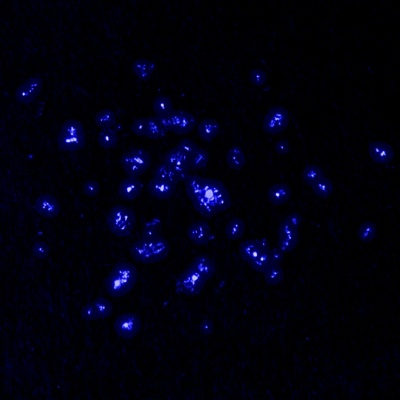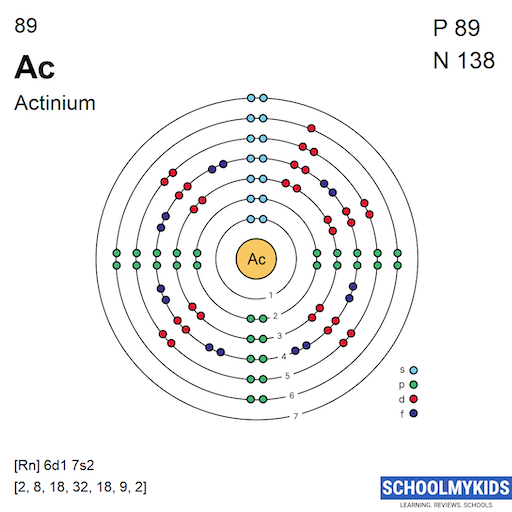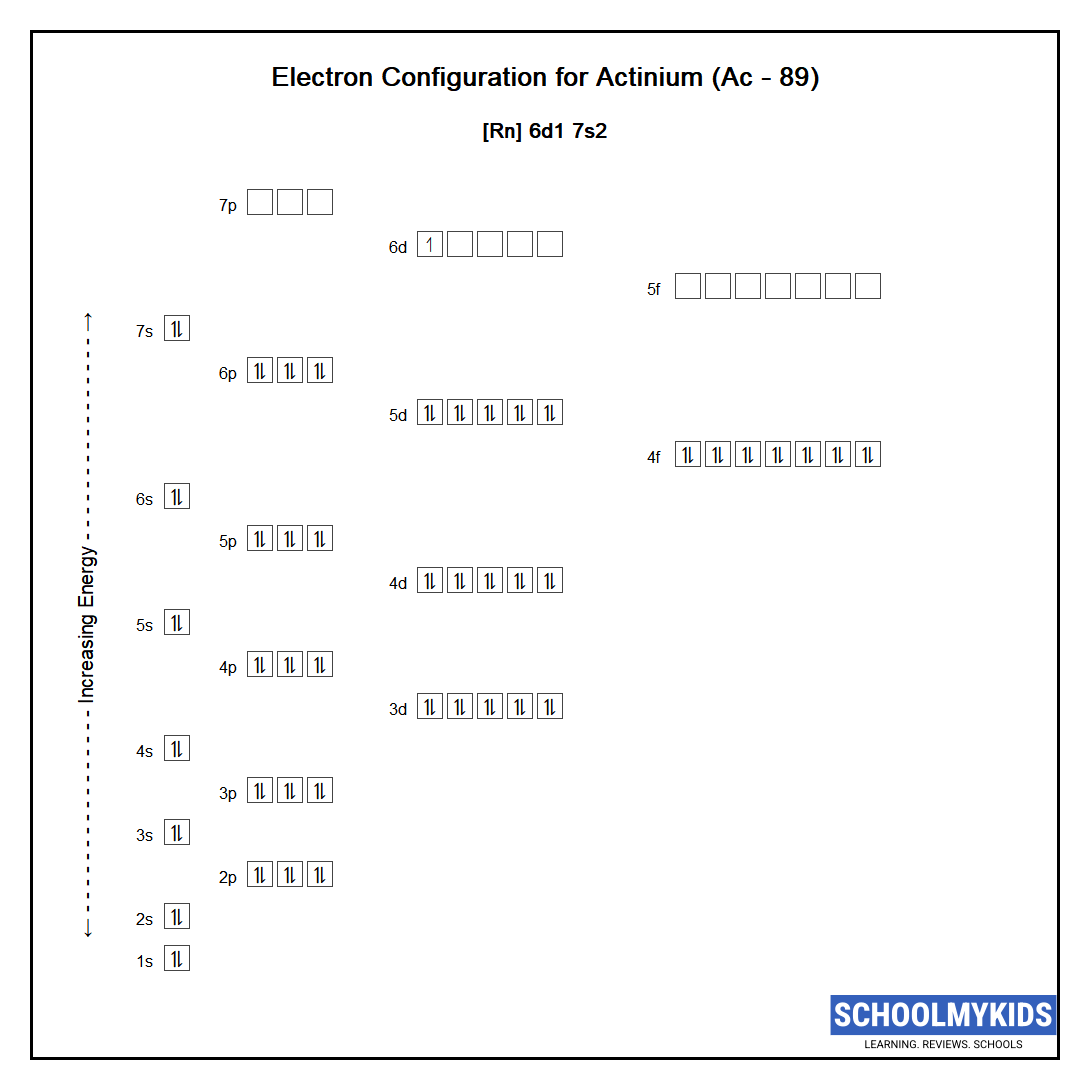Actinium (Ac) - Atomic, Physical & Chemical Properties, Uses, and Periodic Table Trends
Actinium Element Information, Facts, Properties, Trends, Uses, Comparison with other elements

Actinium (Ac) - Comprehensive Element Profile, Properties & Uses
In this comprehensive guide, you'll learn about Actinium's unique chemical and physical properties, trends in the periodic table, isotopes, and its historical significance. We'll also cover its abundance, crystal structure, electron configuration, and health & safety guidelines. Explore how Actinium compares with other elements and discover its many uses.
Actinium is a radioactive chemical element with symbol Ac (not to be confused with the abbreviation for an acetyl group) and atomic number 89, which was discovered in 1899. It was the first non-primordial radioactive element to be isolated. Polonium, radium and radon were observed before actinium, but they were not isolated until 1902.
Actinium is part of Actinide series. You can also download Printable Periodic Table of Elements Flashcards for Actinium in a PDF format.
Actinium Facts
Read key information and facts about element Actinium
| Name | Actinium |
| Atomic Number | 89 |
| Atomic Symbol | Ac |
| Atomic Weight | 227 |
| Phase | Solid |
| Color | Silver |
| Appearance | - |
| Classification | Actinide |
| Natural Occurance | From decay |
| Group in Periodic Table | - |
| Group Name | |
| Period in Periodic Table | period 7 |
| Block in Periodic Table | f-block |
| Electronic Configuration | [Rn] 6d1 7s2 |
| Electronic Shell Structure (Electrons per shell) | 2, 8, 18, 32, 18, 9, 2 |
| Melting Point | 1323 K |
| Boiling Point | 3473 K |
| CAS Number | CAS7440-34-8 |
How to Locate Actinium on Periodic Table
Periodic table is arranged by atomic number, number of protons in the nucleus which is same as number of electrons. The atomic number increases from left to right. Periodic table starts at top left ( Atomic number 1) and ends at bottom right (atomic number 118). Therefore you can directly look for atomic number 89 to find Actinium on periodic table.
Another way to read periodic table and locate an element is by using group number (column) and period number (row). To locate Actinium on periodic table look for cross section of group - and period 7 in the modern periodic table.
Actinium History
The element Actinium was discovered by F. O. Giesel in year 1902 in France. Actinium was first isolated by F. O. Giesel in 1902. Actinium derived its name from the Greek aktis, 'ray'.
| Discovered By | F. O. Giesel |
| Discovery Date | 1902 in France |
| First Isolation | 1902 |
| Isolated by | F. O. Giesel |
Giesel obtained from pitchblende a substance that had properties similar to those of lanthanum and named itemanium. André-Louis Debiernehad previously reported the discovery of a new element actinium that was supposedly similar to titanium and thorium; the elements were mistakenly identified as being identical and Debierne's name was chosen, even though in retrospect Debierne's substance could not have included much actual element 89.
Actinium Uses
The element Actinium has Actinium is used in medicine for radio immunotherapy. It is only found in uranium ore, which makes it very expensive. One ton of uranium produces the equivalent of 1/10th of a gram of actinium.. Since element Actinium has extremely short half-lives
Actinium Presence: Abundance in Nature and Around Us
The table below shows the abundance of Actinium in Universe, Sun, Meteorites, Earth's Crust, Oceans and Human Body.
| ppb by weight (1ppb =10^-7 %) | ppb by atoms (1ppb =10^-7 %) | |
|---|---|---|
| Abundance in Universe | - | - |
| Abundance in Sun | - | - |
| Abundance in Meteorites | - | - |
| Abundance in Earth's Crust | - | - |
| Abundance in Oceans | - | - |
| Abundance in Humans | - | - |
Crystal Structure of Actinium
The solid state structure of Actinium is Face Centered Cubic.
The Crystal structure can be described in terms of its unit Cell. The unit Cells repeats itself in three dimensional space to form the structure.
Unit Cell Parameters
The unit cell is represented in terms of its lattice parameters, which are the lengths of the cell edges Lattice Constants (a, b and c)
| a | b | c |
|---|---|---|
| 567 pm | 567 pm | 567 pm |
and the angles between them Lattice Angles (alpha, beta and gamma).
| alpha | beta | gamma |
|---|---|---|
| π/2 | π/2 | π/2 |
The positions of the atoms inside the unit cell are described by the set of atomic positions ( xi, yi, zi) measured from a reference lattice point.
The symmetry properties of the crystal are described by the concept of space groups. All possible symmetric arrangements of particles in three-dimensional space are described by the 230 space groups (219 distinct types, or 230 if chiral copies are considered distinct.
| Space Group Name | Fm_ 3m |
| Space Group Number | 225 |
| Crystal Structure | Face Centered Cubic |
| Number of atoms per unit cell | 4 |

The number of atoms per unit cell in a simple cubic, face-centered cubic and body-centred cubic are 1,4,2 respectively.
Actinium Atomic and Orbital Properties
Actinium atoms have 89 electrons and the electronic shell structure is [2, 8, 18, 32, 18, 9, 2] with Atomic Term Symbol (Quantum Numbers) 2D3/2.
| Atomic Number | 89 |
| Number of Electrons (with no charge) | 89 |
| Number of Protons | 89 |
| Mass Number | 227 |
| Number of Neutrons | 138 |
| Shell structure (Electrons per energy level) | 2, 8, 18, 32, 18, 9, 2 |
| Electron Configuration | [Rn] 6d1 7s2 |
| Valence Electrons | 6d1 7s2 |
| Valence (Valency) | 3 |
| Main Oxidation States | 3 |
| Oxidation States | 2, 3 |
| Atomic Term Symbol (Quantum Numbers) | 2D3/2 |
Bohr Atomic Model of Actinium - Electrons per energy level

| n | s | p | d | f |
|---|
Ground State Electronic Configuration of Actinium - neutral Actinium atom
Abbreviated electronic configuration of Actinium
The ground state abbreviated electronic configuration of Neutral Actinium atom is [Rn] 6d1 7s2. The portion of Actinium configuration that is equivalent to the noble gas of the preceding period, is abbreviated as [Rn]. For atoms with many electrons, this notation can become lengthy and so an abbreviated notation is used. This is important as it is the Valence electrons 6d1 7s2, electrons in the outermost shell that determine the chemical properties of the element.
Unabbreviated electronic configuration of neutral Actinium
Complete ground state electronic configuration for the Actinium atom, Unabbreviated electronic configuration
1s2 2s2 2p6 3s2 3p6 3d10 4s2 4p6 4d10 5s2 5p6 4f14 5d10 6s2 6p6 6d1 7s2
Electrons are filled in atomic orbitals as per the order determined by the Aufbau principle, Pauli Exclusion Principle and Hund’s Rule.
As per the Aufbau principle the electrons will occupy the orbitals having lower energies before occupying higher energy orbitals. According to this principle, electrons are filled in the following order: 1s, 2s, 2p, 3s, 3p, 4s, 3d, 4p, 5s, 4d, 5p, 6s, 4f, 5d, 6p, 7s, 5f, 6d, 7p…
The Pauli exclusion principle states that a maximum of two electrons, each having opposite spins, can fit in an orbital.
Hund's rule states that every orbital in a given subshell is singly occupied by electrons before a second electron is filled in an orbital.

Atomic Structure of Actinium
Actinium atomic radius is 195 pm, while it's covalent radius is -.
| Atomic Radius Calculated | 195 pm(1.95 Å) |
| Atomic Radius Empirical | 195 pm (1.95 Å) |
| Atomic Volume | 22.5422 cm3/mol |
| Covalent Radius | - |
| Van der Waals Radius | - |
| Neutron Cross Section | 810 |
| Neutron Mass Absorption | 0.079 |
Spectral Lines of Actinium - Atomic Spectrum of Actinium
A spectral line is a dark or bright line in an otherwise uniform and continuous spectrum, resulting from an excess or deficiency of photons in a narrow frequency range, compared with the nearby frequencies. Spectral lines are often used to identify atoms and molecules.
Spectral lines are the result of interaction between a quantum system and a single photon. A spectral line may be observed either as an emission line or an absorption line.
Spectral lines are highly atom-specific, and can be used to identify the chemical composition of any medium. Several elements, including helium, thallium, and caesium, were discovered by spectroscopic means. They are widely used to determine the physical conditions of stars and other celestial bodies that cannot be analyzed by other means.
Emission spectrum of Actinium

Absorption spectrum of Actinium

Actinium Chemical Properties: Actinium Ionization Energies and electron affinity
The electron affinity of Actinium is -.
| Valence | 3 |
| Electronegativity | 1.1 |
| ElectronAffinity | - |
Ionization Energy of Actinium
Ionization energy is the amount of energy required to remove an electron from an atom or molecule.in chemistry, this energy is expresed in kilocalories per mole (kcal/mol) or kilojoules per mole (kJ/mol).
Refer to table below for Ionization energies of Actinium
Here are the ionization energies of Actinium (Ac) both in electron volts (eV) and in kilojoules per mole (kJ/mol).
| Ionization energy number | Enthalpy in kJ/mol | Energy (eV) |
|---|---|---|
| 1st | 499 | 5.172 |
| 2nd | 1170 | 12.126 |
The conversion from kJ/mol to eV is done using the formula:
Energy (kJ/mol) = Energy (eV) x 96.485 Energy (kJ/mol)=Energy (eV)x96.485
where 1 eV = 96.485 kJ/mol.
1 electronvolt (eV) is equal to 96.485 kilojoules per mole (kJ/mol)
Actinium Physical Properties
Refer to below table for Actinium Physical Properties
| Density | 10.07 g/cm3 |
| Molar Volume | 22.5422 cm3/mol |
Elastic Properties
| Young Modulus | - |
| Shear Modulus | - |
| Bulk Modulus | - |
| Poisson Ratio | - |
Hardness of Actinium - Tests to Measure of Hardness of Element
| Mohs Hardness | - |
| Vickers Hardness | - |
| Brinell Hardness | - |
Actinium Electrical Properties
Electrical resistivity measures element's electrical resistance or how strongly it resists electric current.The SI unit of electrical resistivity is the ohm-metre (Ω⋅m). While Electrical conductivity is the reciprocal of electrical resistivity. It represents a element's ability to conduct electric current. The SI unit of electrical conductivity is siemens per metre (S/m).
Actinium is a -. Refer to table below for the Electrical properties of Actinium
| Electrical conductors | - |
| Electrical Conductivity | - |
| Resistivity | - |
| Superconducting Point | - |
Actinium Heat and Conduction Properties
| Thermal Conductivity | 12 W/(m K) |
| Thermal Expansion | - |
Actinium Magnetic Properties
| Magnetic Type | - |
| Curie Point | - |
| Mass Magnetic Susceptibility | - |
| Molar Magnetic Susceptibility | - |
| Volume Magnetic Susceptibility | - |
Optical Properties of Actinium
| Refractive Index | - |
Acoustic Properties of Actinium
| Speed of Sound | - |
Actinium Thermal Properties - Enthalpies and thermodynamics
Refer to table below for Thermal properties of Actinium
| Melting Point | 1323 K(1049.85 °C, 1921.730 °F) |
| Boiling Point | 3473 K(3199.85 °C, 5791.730 °F) |
| Critical Temperature | - |
| Superconducting Point | - |
Enthalpies of Actinium
| Heat of Fusion | 14 kJ/mol |
| Heat of Vaporization | 400 kJ/mol |
| Heat of Combustion | - |
Actinium Isotopes - Nuclear Properties of Actinium
Actinium has 31 isotopes, with between 206 and 236 nucleons. Actinium has 0 stable naturally occuring isotopes.
Isotopes of Actinium - Naturally occurring stable Isotopes: -.
| Isotope | Z | N | Isotope Mass | % Abundance | T half | Decay Mode |
|---|---|---|---|---|---|---|
| 206Ac | 89 | 117 | 206 | Synthetic | ||
| 207Ac | 89 | 118 | 207 | Synthetic | ||
| 208Ac | 89 | 119 | 208 | Synthetic | ||
| 209Ac | 89 | 120 | 209 | Synthetic | ||
| 210Ac | 89 | 121 | 210 | Synthetic | ||
| 211Ac | 89 | 122 | 211 | Synthetic | ||
| 212Ac | 89 | 123 | 212 | Synthetic | ||
| 213Ac | 89 | 124 | 213 | Synthetic | ||
| 214Ac | 89 | 125 | 214 | Synthetic | ||
| 215Ac | 89 | 126 | 215 | Synthetic | ||
| 216Ac | 89 | 127 | 216 | Synthetic | ||
| 217Ac | 89 | 128 | 217 | Synthetic | ||
| 218Ac | 89 | 129 | 218 | Synthetic | ||
| 219Ac | 89 | 130 | 219 | Synthetic | ||
| 220Ac | 89 | 131 | 220 | Synthetic | ||
| 221Ac | 89 | 132 | 221 | Synthetic | ||
| 222Ac | 89 | 133 | 222 | Synthetic | ||
| 223Ac | 89 | 134 | 223 | Synthetic | ||
| 224Ac | 89 | 135 | 224 | Synthetic | ||
| 225Ac | 89 | 136 | 225 | Synthetic | ||
| 226Ac | 89 | 137 | 226 | Synthetic | ||
| 227Ac | 89 | 138 | 227 | Synthetic | 21.7865 years | BetaDecay |
| 228Ac | 89 | 139 | 228 | Synthetic | ||
| 229Ac | 89 | 140 | 229 | Synthetic | ||
| 230Ac | 89 | 141 | 230 | Synthetic | ||
| 231Ac | 89 | 142 | 231 | Synthetic | ||
| 232Ac | 89 | 143 | 232 | Synthetic | ||
| 233Ac | 89 | 144 | 233 | Synthetic | ||
| 234Ac | 89 | 145 | 234 | Synthetic | ||
| 235Ac | 89 | 146 | 235 | Synthetic | ||
| 236Ac | 89 | 147 | 236 | Synthetic |
Regulatory and Health - Health and Safety Parameters and Guidelines
The United States Department of Transportation (DOT) identifies hazard class of all dangerous elements/goods/commodities either by its class (or division) number or name. The DOT has divided these materials into nine different categories, known as Hazard Classes.
NFPA 704 is a Standard System for the Identification of the Hazards of Materials for Emergency Response. NFPA is a standard maintained by the US based National Fire Protection Association.
The health (blue), flammability (red), and reactivity (yellow) rating all use a numbering scale ranging from 0 to 4. A value of zero means that the element poses no hazard; a rating of four indicates extreme danger.
| NFPA Fire Rating | N/A | N/A |
| NFPA Health Rating | N/A | N/A |
| NFPA Reactivity Rating | N/A | N/A |
| NFPA Hazards | N/A |
| Autoignition Point | - |
| Flashpoint | - |
Database Search
List of unique identifiers to search the element in various chemical registry databases
| Database | Identifier number |
|---|---|
| CAS Number - Chemical Abstracts Service (CAS) | CAS7440-34-8 |
| RTECS Number | - |
| CID Number | - |
| Gmelin Number | - |
| NSC Number | - |
Compare Actinium with other elements
Compare Actinium with Group , Period 7 and Actinide elements of the periodic table.
Compare Actinium with all Group elements
Compare Actinium with all Period 7 elements
Compare Actinium with all Actinide elements
Frequently Asked Questions (FAQ)
Find the answers to the most frequently asked questions about Actinium